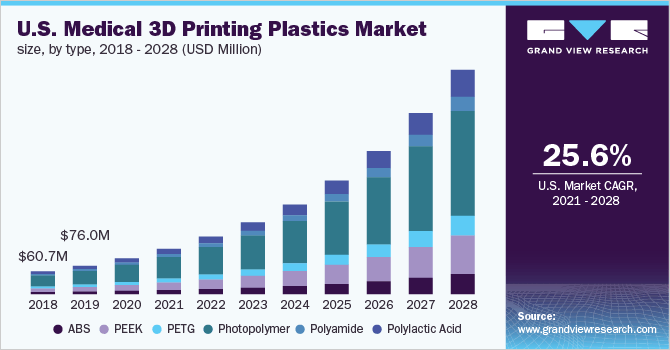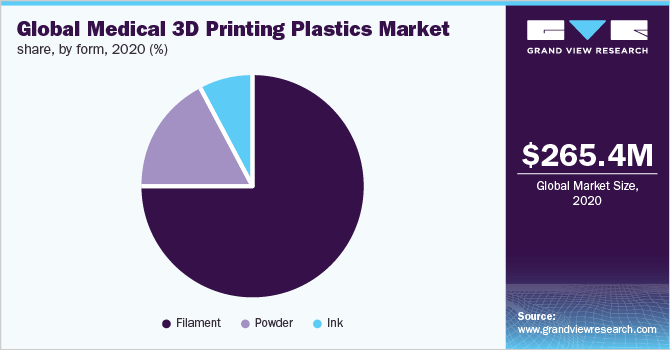- Home
- »
- Plastics, Polymers & Resins
- »
-
Medical 3D Printing Plastics Market Size & Share Report, 2028GVR Report cover
![Medical 3D Printing Plastics Market Size, Share & Trends Report]()
Medical 3D Printing Plastics Market Size, Share & Trends Analysis Report By Type (ABS, PEEK, PETG, Photopolymer, Polyamide, Polylactic Acid), By Form (Filament, Powder, Ink), And Segment Forecasts, 2021 - 2028
- Report ID: GVR-4-68038-717-9
- Number of Report Pages: 120
- Format: PDF, Horizon Databook
- Historical Range: 2017 - 2019
- Forecast Period: 2021 - 2028
- Industry: Bulk Chemicals
Report Overview
The global medical 3D printing plastics market size was valued at USD 265.4 million in 2020 and is expected to grow at a compound annual growth rate (CAGR) of 26.2% from 2021 to 2028. The growing aging population, increasing healthcare awareness, and the COVID-19 pandemic situation are some of the major factors driving the market for medical 3D printing plastics.
The market is primarily driven by rising demand for face masks, head and shoe covers, surgical masks and gloves, personal protective gowns, and various other products in tackling the COVID-19 pandemic situation. Besides personal protective wearables, medical 3D printing plastics are widely used in the manufacturing of medical products, such as dental and bone implants, catheters, prosthetics, and various other medical devices.

In order to overcome the COVID-19 pandemic situation, various automotive companies such as Ford Motor Company, General Motors Company, and Tesla have started producing masks and face covers using state-of-the-art 3D printing technology to cater to the sudden increase in demand for these products. Additionally, various fashion industry companies such as CHANEL, Burberry Limited, Guccio Gucci S.p.A., Dior, and Louis Vuitton have started producing mask and face covers, which is driving the demand for medical 3D printing plastics.
Thermoplastics like PEEK, polylactic acid, and photopolymers are among the commonly utilized plastics in the medical 3D industry on account of the biodegradable nature of the material. Major technologies utilized by the medical industry for 3D printing include stereolithography (SLA), digital light processing (DLP), selective layer sintering (SLS), fused deposition modeling (FDM), and electronic beam melting (EBM), and polyjet/inkjet 3D printing.
Key factors propelling demand for medical 3D printing plastics include cost-effectiveness, ease in customization, and growing incidences of vascular and osteoarthritis diseases. Moreover, improved technology, favorable government support, and rapid product development are expected to propel the demand for medical 3D printing plastics over the forecast period.
Type Insights
In terms of revenue, photopolymer dominated the market with a share of 47.9% in 2020. This is attributed to the high demand for catheters, hearing aids, surgical masks, medical filters, drug delivery systems, and tissue engineering and cell encapsulation systems. Photopolymer possesses excellent thermo-mechanical properties, such as resistance to chemicals and high thermal accuracy, and it changes its phase from solid to liquid under ultraviolet light. These properties make it suitable for medical 3D printing applications.
ABS is widely used in the medical 3D printing process using a fused deposition modeling process. It is used to produce medical equipment, nebulizers, compressors, and various other products. ABS possesses properties, such as higher strength, flexibility, and durability. ABS can be replaced with polylactic acid as it is biodegradable whereas ABS is biocompatible. Moreover, ABS is recyclable, which makes it suitable for the production of prosthetics. Rising health awareness and the growing aged population are expected to drive the demand for medical 3D printing plastics over the forecast period.
Form Insights
In terms of revenue, filament dominated the market with a share of 75.1% in 2020. Increasing utilization of medical 3D printing plastics to produce a wide range of healthcare products, such as specialized surgical tools in reusable and single-use medical devices, is boosting the segment growth. Filament form can be used in various 3D printing processes, including fused deposition modeling (FDM), stereolithography (SLA), selective laser sintering (SLS), and electron beam melting (EMB), based on the type of nozzle.
Medical 3D printing plastics such as ABS, PEEK, PETG, photopolymer, polyamide, and polylactic acid are primarily used in filament form in the 3D printing process. The filament form of 3D printing plastics can be widely used in other applications, such as automotive, aerospace and defense, electrical and electronics, and consumer goods, based on the specific requirement.

The powder form of medical 3D printing plastics produces components that possess properties, such as ductility, shock resistance, and elasticity. The powder form of 3D printing material is primarily used in the selective laser sintering process. Components produced using powder, along with selective laser sintering, have high dimensional accuracy and no post-processing. Moreover, components with thin walls and complex shapes can be produced very easily.
Regional Insights
North America dominated the market for medical 3D printing plastics with a volume share of 45.9% in 2020. This is attributed to various factors such as rising awareness among the consumers, increasing healthcare spending, and growing demand for disposable plastics. The main products driving the demand for plastics include masks, surgical gloves, orthopedic sutures, inhalation masks, and catheters. In addition, rapidly rising COVID-19 positive cases in the U.S. are expected to result in an increased demand for generic drugs and medical devices, which is driving the demand for medical 3D printing plastics, thereby positively influencing the market growth in the region over the forecast period.
Asia Pacific is expected to expand at the fastest CAGR of 27.3% in terms of volume from 2021 to 2028. The regional market is majorly driven by growing demand from developing economies, such as China, India, and Malaysia. The countries in the Asia Pacific are investing in the healthcare industry owing to the rising population, GDP growth, which has positively impacted the living standards, and rising healthcare awareness among the consumers. Moreover, the growing elderly population, along with other factors, is expected to drive the demand for medical 3D printing plastics over the forecast period.
Key Companies & Market Share Insights
Most of the key players operating in the market have integrated their raw material production and distribution operations to maintain product quality and expand their regional presence. This provides companies a competitive advantage in the form of cost benefits, thus increasing the profit margins. Companies are undertaking research and development activities to develop new industrial plastics to sustain market competition and changing end-user requirements. Research activities focused on the development of new medical 3D printing materials, which combine several properties, are projected to gain wide acceptance in this industry in the coming years. Some of the prominent players in the global medical 3D printing plastics market include:
-
3D Systems, Inc.
-
Apium Additive Technologies GmbH
-
Arkema
-
DSM
-
ENVISIONTEC, INC.
-
Evonik Industries AG
-
SABIC
-
Solvay
-
Stratasys Ltd.
- Victrex plc.
Medical 3D Printing Plastics Market Report Scope
Report Attribute
Details
Market size value in 2021
USD 337.04 million
Revenue forecast in 2028
USD 1.7 billion
Growth Rate
CAGR of 26.2% from 2021 to 2028
Base year for estimation
2020
Historical data
2017 - 2019
Forecast period
2021 - 2028
Quantitative units
Volume in tons, revenue in USD million and CAGR from 2021 to 2028
Report coverage
Volume and revenue forecast, company ranking, competitive landscape, growth factors, and trends
Segments covered
Type, form, region
Regional scope
North America; Europe; Asia Pacific; Central & South America; MEA
Country scope
U.S.; Canada; Mexico; U.K.; Germany; France; Italy; China; India; Japan; Brazil; Argentina; Saudi Arabia; South Africa
Key companies profiled
3D Systems, Inc.; Apium Additive Technologies GmbH; Arkema; DSM; ENVISIONTEC, INC.; Evonik Industries AG; SABIC; Solvay; Stratasys Ltd; Victrex plc.
Customization scope
Free report customization (equivalent up to 8 analysts working days) with purchase. Addition or alteration to country, regional & segment scope.
Pricing and purchase options
Avail customized purchase options to meet your exact research needs. Explore purchase options
Segments Covered in the ReportThis report forecasts revenue and volume growth at the global, regional, and country levels and provides an analysis of the latest industry trends and opportunities in each of the sub-segments from 2017 to 2028. For the purpose of this study, Grand View Research has segmented the global medical 3D printing plastics market report on the basis of type, form, and region:
-
Type Outlook (Volume, Tons; Revenue, USD Million, 2017 - 2028)
-
ABS
-
PEEK
-
PETG
-
Photopolymer
-
Polyamide
-
Polylactic Acid
-
-
Form Outlook (Volume, Tons; Revenue, USD Million, 2017 - 2028)
-
Filament
-
Powder
-
Ink
-
-
Regional Outlook (Volume, Tons; Revenue, USD Million, 2017 - 2028)
-
North America
-
The U.S.
-
Canada
-
Mexico
-
-
Europe
-
Germany
-
The U.K.
-
France
-
Italy
-
-
Asia Pacific
-
China
-
India
-
Japan
-
-
Central & South America
-
Brazil
-
Argentina
-
-
Middle East & Africa
-
Saudi Arabia
-
South Africa
-
-
Frequently Asked Questions About This Report
b. The global medical 3D printing plastics market size was estimated at USD 265.4 million in 2020 and is expected to reach USD 337.0 million in 2021.
b. The global medical 3D printing plastics market is expected to grow at a compound annual growth rate of 26.2% from 2021 to 2028 to reach USD 1.7 billion by 2028.
b. North America dominated the medical 3D printing plastics market with a share of 45.9% in 2020. This is attributable to various factors such as the rising awareness among the consumers, increasing healthcare spending, and rising demand of disposable plastics.
b. Some key players operating in the medical 3D printing plastics market include 3D Systems, Inc.; Apium Additive Technologies GmbH; Arkema; DSM; ENVISIONTEC, INC.; Evonik Industries AG; SABIC; Solvay; Stratasys Ltd; and Victrex plc.
b. Key factors that are driving the market growth include rising demand of medical 3D printing plastics in the manufacturing of various products such as mask, face covers, surgical gloves, and protective gowns.
Share this report with your colleague or friend.
![gvr icn]()
NEED A CUSTOM REPORT?
We can customize every report - free of charge - including purchasing stand-alone sections or country-level reports, as well as offer affordable discounts for start-ups & universities. Contact us now
![Certified Icon]()
We are GDPR and CCPA compliant! Your transaction & personal information is safe and secure. For more details, please read our privacy policy.
We are committed towards customer satisfaction, and quality service.
"The quality of research they have done for us has been excellent."





